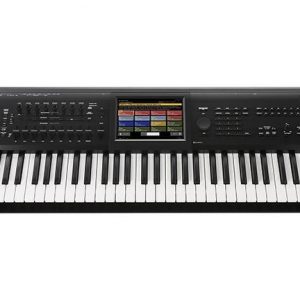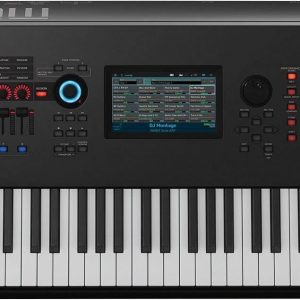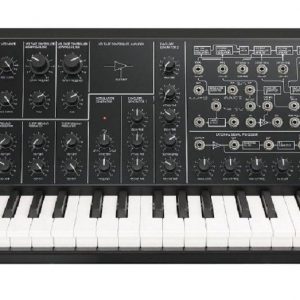Description
Behringer TD-3 Synthesizer: A Revolutionary Tool for Music Production
Behringer TD-3 synthesizer is a high-performance and versatile analog bass synthesizer that will take your music production to the next level. It takes inspiration from the iconic Roland TB-303 synthesizer, which has a place in the history of electronic music production.
Behringer TD-3 synthesizer is one of the most sought-after and affordable synthesizers in the market today. It has built a reputation for its compact design, making it easy to transport and set up. Its features are powerful and easy to use, making it an excellent tool for both beginners and professionals.
Features
The Behringer TD-3 synthesizer has a comprehensive set of features that make it stand out from the rest. It has MIDI connectivity, which allows it to connect to a computer or any other MIDI-enabled device. It features a built-in sequencer that can record up to 64 steps of music, and it can store up to 250 patterns.
The synthesizer also comes with an arpeggiator, which generates complex patterns that can be synced with the tempo of your music. The arpeggiator can be customized to play in any direction, including up, down, and random. It also features variable range and a hold function, which allows you to hold down the notes played by the arpeggiator.
Design
The Behringer TD-3 synthesizer’s design is reminiscent of the original Roland TB-303 synthesizer. Its compact design makes it an ideal tool for live performances, and its intuitive interface makes it easy to use. The synthesizer is available in multiple colors, including silver, red, and blue.
The front panel of the TD-3 synthesizer is laid out in a logical and intuitive manner, with all the essential controls easily accessible. It has an LED panel that displays the settings of the synthesizer, making it easy to navigate and tweak.
Sound Quality
The Behringer TD-3 synthesizer packs a powerful punch when it comes to sound quality. It produces analog sounds with great clarity and depth, which are ideal for a wide range of music genres, including techno, house, and acid.
The synthesizer features a 24dB low pass filter, which is known for its distinctive sound. It has resonance control, which allows you to adjust the sharpness of the filter’s cutoff frequency. The synthesizer also comes with a distortion effect, which enhances its analog sound further.
Conclusion
The Behringer TD-3 synthesizer is a must-have tool for any music producer looking to create analog basslines. It has a robust set of features that are easy to use, making it accessible to beginners and professionals alike. The synthesizer’s compact design and affordable price make it an excellent choice for live performances and home studio setups.
Overall, the Behringer TD-3 synthesizer is a powerful tool that provides an analog sound that is difficult to match in terms of depth and clarity. If you are looking for a reliable and versatile analog bass synthesizer, then the Behringer TD-3 synthesizer is an excellent choice.
Behringer TD-3 properties
| Product name | TD-3 |
| Brand | Behringer |
| Type | Keyboard Instruments |
| Keyboard Instrument | Synthesizer |
| Key Functions | Touch Sensitive |
| Rotary Controls | Yes |
| Connections | Headphone, MIDI, MIDI In, MIDI Thru, USB |
| Colour | Black, Blue, Green, Red, Silver, Yellow |
| Power Supply | Electrical Cable to Wall Socket |
 Korg microKORG XL
Korg microKORG XL 







Walter Ryan –
The device hums slightly, without any tragedy, but noticeably compared to the pure Monologue signal. On the manufacturer’s website you will find a system patch. There is also an unofficial patch which, in addition to the fixes from KORG, has some additional improvements, including cooperation with VST Dexed as a device parameters panel (I haven’t tested this option yet). FM synthesis is a new area for me … I do not know yet how Volca FM will fit in my set, but I am sure of one thing – KORG created a cult instrument.
Jordan Hood –
Rotary controls, as found in synthesizers like the Behringer TD-3, are analog knobs that allow for precise and smooth adjustments of various parameters such as filter frequency, resonance, volume, and more. These controls offer a tactile feedback to the user, making it easier to fine-tune their sound without relying solely on digital displays or menus.
But why should you care about rotary controls in your synthesizer? Well, for starters, they can significantly enhance your creative flow and expression by providing a more intuitive and musical way of adjusting sounds than traditional button-based interfaces. Rotary controls also offer a more reliable and durable solution than modern digital encoders or touchpads, as they are less prone to breaking down due to wear and tear over time.
Now, let’s talk about power efficiency. The Behringer TD-3 is not only a great synthesizer in its own right, but also an eco-friendly one. With its low power consumption, you can save money on your electricity bills while reducing your carbon footprint. And the best part? You won’t have to compromise on features or performance to achieve this environmental benefit – the TD-3 still packs a punch when it comes to sound quality and versatility.
When comparing amateur and professional use of synthesizers like the Behringer TD-3, it’s essential to recognize that both categories have unique needs and preferences. For beginners, rotary controls may offer a more intuitive and forgiving interface due to their tactile feedback and less digital complexity. On the other hand, professionals often require more precise and customizable control over parameters, which can be achieved through advanced features such as MIDI learn, programmable presets, and CV/Gate inputs that the TD-3 also offers.
Finally, let’s talk about the Behringer TD-3’s rotary controls specifically. Unlike some digital alternatives that may have a more sterile or unresponsive feel, the TD-3’s rotaries are smooth and precise, offering a satisfying and musical experience for the user. Additionally, their placement and layout on the front panel is intuitive and logical, making it easy to access and adjust different parameters without having to refer to manuals or online guides.
In summary, whether you’re a seasoned pro or a newbie just starting out in synthesis, the Behringer TD-3’s rotary controls offer a wealth of benefits that can enhance your musical experience and help save the planet at the same time. So why wait? Grab yours today and start exploring the world of analog synth sounds!
But seriously folks, let’s not forget the irony and sarcasm inherent in promoting environmental friendliness through the purchase of a synthesizer. While we do encourage sustainable and eco-conscious practices in our everyday lives, it’s important to remember that the production, transport, and disposal of electronic devices can still have an impact on the environment. So while we celebrate the TD-3’s low power consumption, let’s also strive to reduce our overall technology consumption and footprint as much as possible. After all, music and the environment are both precious resources that should be cherished and protected for future generations.
Brynn Gilliam –
**A Different Perspective on Behringer TD-3: Do Rotary Controls Really Matter?**
As I read Jordan Hood’s glowing review of the Behringer TD-3, I couldn’t help but wonder if we’re placing too much emphasis on rotary controls. Don’t get me wrong, I love a good tactile experience as much as the next musician, but are they really worth all the fuss?
In today’s news, we see the devastating effects of environmental disasters on innocent people like Steve and Gill Wallis, who lost everything to a burst water main. It’s a stark reminder that our priorities should be shifting towards sustainability and responsible consumption.
Considering this, I question whether the Behringer TD-3’s rotary controls are truly worth celebrating. While they do offer a tactile feedback that some users may prefer, aren’t we just perpetuating a cycle of technology dependency? We buy devices like the TD-3, use them for a while, and then discard them when they become obsolete.
Moreover, I’m not convinced that rotary controls necessarily make the TD-3 more musical or intuitive. In fact, some users may find them cumbersome or even distracting in certain situations. And what about those who prefer digital interfaces? Are we just forcing people to conform to a certain type of user experience?
In my opinion, the Behringer TD-3’s true value lies not in its rotary controls, but in its versatility and affordability. It’s an accessible synthesizer that can help new musicians develop their skills without breaking the bank. But let’s be real we’re still contributing to electronic waste and pollution.
So while I appreciate Jordan Hood’s enthusiasm for the TD-3, I think we should take a step back and reevaluate our priorities. Can we find more innovative ways to make music that don’t rely on disposable technology?
Melissa –
Walter Ryan’s admiration for the Behringer TD-3 feels almost reverent, yet I find myself questioning whether its subtle hum and reliance on patches—both official and unofficial—are signs of a device still finding its footing rather than a fully realized instrument. While KORG’s FM synthesis may inspire cultish devotion, my own experimentation with modular systems has left me skeptical of how deeply this hardware integrates into workflows beyond its niche; the promise of AI-driven automation in fields like sales tax (as seen in Numeral’s $35M raise) feels oddly parallel—both aim to streamline complexity, yet one risks oversimplifying the artistry involved.